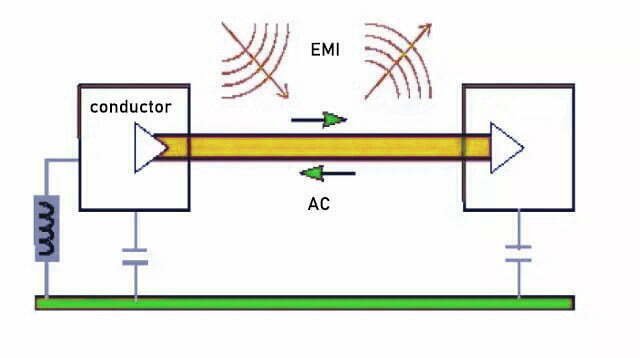What is Electromagnetic Interference (EMI)?
Electromagnetic interference (EMI) is an undesirable phenomenon that can occur in any electrical circuit. It is generally caused by the presence of strong electromagnetic fields and has the potential to disrupt or interfere with the normal operation of sensitive electronics.
If left unchecked, EMI can hurt the performance of electronic devices and integrated circuits. For this reason, engineers have developed various strategies for preventing EMI from occurring in their designs. These strategies include using shielded cables, metal enclosure, balanced lines and differential signaling protocols. In this article, we will go over several common examples of electromagnetic interference and explain how you can mitigate these effects in your designs.

EMI vs EMC
EMI and EMC are both important concepts in the world of electronics. They are related, but they are not the same thing.
EMI is short for electromagnetic interference. This is when one electronic device emits electromagnetic energy that interferes with another device. The result can be anything from a slight degradation in performance to a complete breakdown of the affected device.
EMC is short for electromagnetic compatibility. This is the ability of electronic devices to function properly in an environment that contains electromagnetic energy. This includes everything from naturally occurring background radiation to signals emitted by other devices.
EMI and EMC are both important considerations when designing and using electronic devices. EMI can be a problem if it is not taken into account, but it can also be used to advantage in some cases. For example, radio frequency identification (RFID) tags use EMI to communicate with reader devices. EMI can also be used for medical purposes, such as MRI scans.
EMC is important to consider in any situation where electronic devices are present. Any device that emits electromagnetic energy can potentially cause problems for other devices, so it is important to make sure that all devices are compatible with each other. This can be a challenge in environments where there are many different types of devices present, such as office buildings or hospitals.
electromagnetic interference sources
There are a variety of sources of electromagnetic interference (EMI), which can come from both man-made and natural sources. Man-made sources include electrical equipment, such as power lines, electrical transformers, and electronic devices. Natural sources of EMI include lightning and solar flares.
Types of EMI
There are two types of EMI, conducted interference and radio frequency interference (RFI). When a signal on one electrical network couples (interferes) with another electrical network through a conductive medium, that is referred to as conducted interference. When a source of interference couples (interferes) its signal with another electrical network through space, that is called radio frequency interference.
Conducted Interference
Conducted interference is divided into two types: Common-mode interference (CMI) and Differential-mode interference (DMI).
Common-mode interference
Common-mode interference is when two signals of the same frequency and waveform, but with different amplitudes, interfere with each other. It is transmitted between the wire and the ground, the current on the two wires are the same directions. It belongs asymmetrical interference.

Common-mode interference is typically caused by external factors such as electromagnetic fields or electrical noise. It can also be caused by internal factors such as crosstalk between wires or components.
Differential-mode interference
Differential-mode interference is when two signals of the same frequency and waveform, but with different phases, interfere with each other. It is transmitted between two wires and the currents on the two wires are in opposite directions. It belongs to symmetrical interference.

Differential-mode interference can happen when two signals are close in frequency, or when one signal is much stronger than the other.
Radio Frequency Interference (RFI)
Radio Frequency Interference (RFI) is any signal that can interfere with the normal operation of a radio receiver. RFI can come from a variety of sources, including power lines, transmitters, high-power amplifiers, electrical appliances, and even other radios.
This type of EMI can be reduced by placing a metal enclosure around the circuitry or sensitive devices to prevent the electromagnetic field from traveling beyond its boundaries. Unfortunately, there is no easy way to shield high-frequency signals from this EMI.
Strategies to Mitigate the Impact of EMI
There are a number of strategies that can be employed to mitigate the impact of electromagnetic interference (EMI). Some of these include:
Use of filters
Filters can be used to prevent EMI from entering electrical equipment. This involves installing components, such as filters, inductors, and capacitors, that will block or attenuate the electromagnetic energy.
Use of grounding
Grounding can help to reduce the impact of EMI by providing a path for the interference to dissipate. This involves connecting the device or system to a ground reference, such as a metal plate or wire, that will dissipate the electromagnetic energy.
Use of shielding
Shielding can help to reduce the amount of EMI that is emitted by electrical equipment. This can be done by enclosing the device or system that is susceptible to EMI in a conductive material, such as metal, that will reflect or absorb the electromagnetic energy.
Use of proper wiring practices
Proper wiring practices can help to reduce the amount of EMI that is emitted by electrical equipment.






